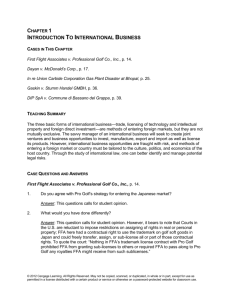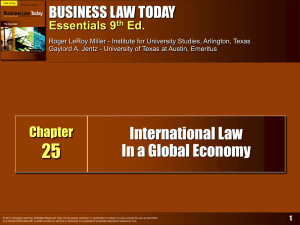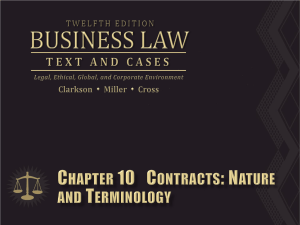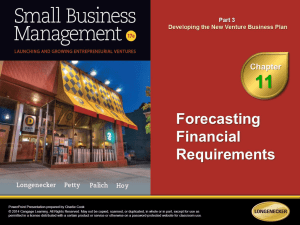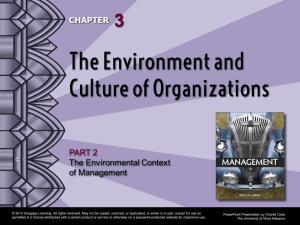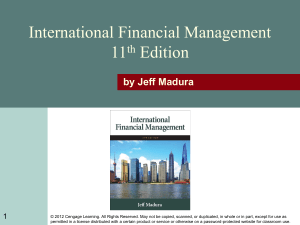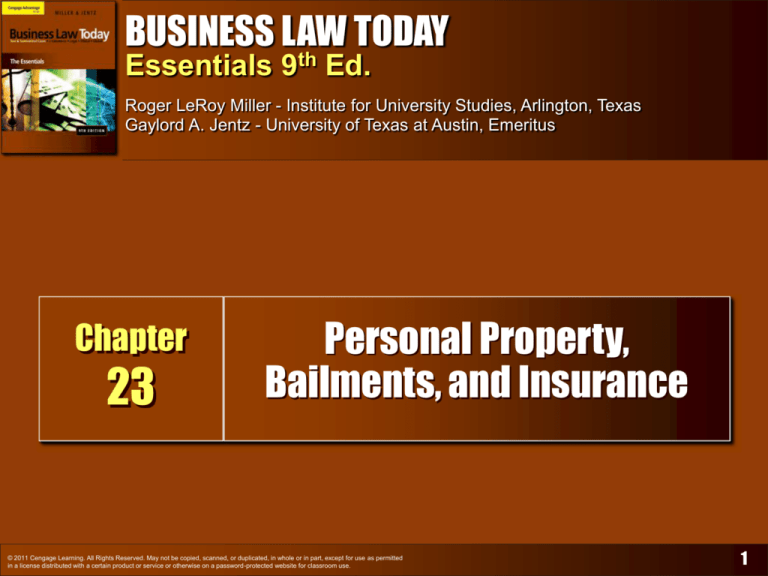
BUSINESS LAW TODAY
Essentials 9th Ed.
Roger LeRoy Miller - Institute for University Studies, Arlington, Texas
Gaylord A. Jentz - University of Texas at Austin, Emeritus
Chapter
23
Personal Property,
Bailments, and Insurance
© 2011 Cengage Learning. All Rights Reserved. May not be copied, scanned, or duplicated, in whole or in part, except for use as permitted
in a license distributed with a certain product or service or otherwise on a password-protected website for classroom use.
1
Learning Objectives
What is real property?
What is personal
property?
What is the difference between joint tenancy
and tenancy in common?
What are the three elements necessary for
an effective gift?
What are the three elements of a bailment?
What is an insurable interest? When must an
insurable interest exist – at the time the
insurance policy is obtained, at the time the
loss occurs, or both?
© 2011 Cengage Learning. All Rights Reserved. May not be copied, scanned, or duplicated, in whole or in part, except for use as permitted
in a license distributed with a certain product or service or otherwise on a password-protected website for classroom use.
2
Introduction
Definition: Property consists of legally
protected rights and interests a person
has in anything with an ascertainable
value that is subject to ownership.
Difference Between Real and Personal Property.
Ownership rights in each.
Acquiring Ownership of Personal Property.
Laws Governing Mislaid, Lost, or Abandoned
Property.
© 2011 Cengage Learning. All Rights Reserved. May not be copied, scanned, or duplicated, in whole or in part, except for use as permitted
in a license distributed with a certain product or service or otherwise on a password-protected website for classroom use.
3
Property Ownership
Property ownership is viewed as a
“bundle of rights”, including the:
Right to possess.
Right to sell.
Right to give.
Right to lease.
Right to destroy.
© 2011 Cengage Learning. All Rights Reserved. May not be copied, scanned, or duplicated, in whole or in part, except for use as permitted
in a license distributed with a certain product or service or otherwise on a password-protected website for classroom use.
4
Fee Simple
Owner owns the entire “bundle of
rights”.
Fee simple gives the owner the maximum
possible estate or right of ownership of
real property, continuing forever.
Chapter 36 will deal with realty estates.
© 2011 Cengage Learning. All Rights Reserved. May not be copied, scanned, or duplicated, in whole or in part, except for use as permitted
in a license distributed with a certain product or service or otherwise on a password-protected website for classroom use.
5
Tenancy in Common
A and B own an
undivided interest
in the property.
Upon B’s death
interest passes to
B’s heir, “C”.
The new owners of
the property are A
and C.
© 2011 Cengage Learning. All Rights Reserved. May not be copied, scanned, or duplicated, in whole or in part, except for use as permitted
in a license distributed with a certain product or service or otherwise on a password-protected website for classroom use.
A
X
B
C
6
Joint Tenancy
•A and B own a Joint
Tenant interest in
property.
•Upon B’s death, B’s
interest
automatically passes
to A, the surviving
joint tenant.
© 2011 Cengage Learning. All Rights Reserved. May not be copied, scanned, or duplicated, in whole or in part, except for use as permitted
in a license distributed with a certain product or service or otherwise on a password-protected website for classroom use.
A
X
B
7
Community Property
Community Property (limited number of
states)
Property acquired by couple during their
marriage is owned as an undivided ½ interest in
property (real and personal).
© 2011 Cengage Learning. All Rights Reserved. May not be copied, scanned, or duplicated, in whole or in part, except for use as permitted
in a license distributed with a certain product or service or otherwise on a password-protected website for classroom use.
8
Real Property Ownership
© 2011 Cengage Learning. All Rights Reserved. May not be copied, scanned, or duplicated, in whole or in part, except for use as permitted
in a license distributed with a certain product or service or otherwise on a password-protected website for classroom use.
9
Acquiring Ownership of
Personal Property
Possession.
Capture of wild animals (wild animals belong to
no one).
Finding of abandoned property.
Adverse Possession.
Production.
Writers, inventors, manufacturers, and others
who produce personal property acquire title to it.
© 2011 Cengage Learning. All Rights Reserved. May not be copied, scanned, or duplicated, in whole or in part, except for use as permitted
in a license distributed with a certain product or service or otherwise on a password-protected website for classroom use.
10
Gifts
Voluntary transfer of property ownership
from Donor (owner) to Donee (recipient) for
no consideration.
Requirements:
Donative Intent.
Delivery—actual or “constructive” (symbolic, such as
keys to car). Relinquishing Dominion and Control:
Donor must give up complete control or dominion.
CASE 23.1 In re Estate of Piper (1984). There was
no evidence of actual delivery of the rings to plaintiff
Kaufmann. Thus the rings remained in the estate of
Piper.
Acceptance by donee.
© 2011 Cengage Learning. All Rights Reserved. May not be copied, scanned, or duplicated, in whole or in part, except for use as permitted
in a license distributed with a certain product or service or otherwise on a password-protected website for classroom use.
11
Types of Gifts
Three types
Intervivos—while donor is living.
Causa Mortis: -- made by donor in
contemplation of imminent death.
Testamentary – after death, by will/inheritance.
© 2011 Cengage Learning. All Rights Reserved. May not be copied, scanned, or duplicated, in whole or in part, except for use as permitted
in a license distributed with a certain product or service or otherwise on a password-protected website for classroom use.
12
Acquiring Ownership of
Personal Property
Accession.
Someone adds value to a piece of personal
property by use of either labor or materials.
Confusion.
Commingling so that a person’s personal
property cannot be distinguished from
another’s.
Fungible goods consists of identical particles
such as oil or grain.
© 2011 Cengage Learning. All Rights Reserved. May not be copied, scanned, or duplicated, in whole or in part, except for use as permitted
in a license distributed with a certain product or service or otherwise on a password-protected website for classroom use.
13
Mislaid, Lost, and Abandoned Property
Mislaid Property: Voluntary placed
somewhere, then inadvertently forgotten.
Finder is steward for true owner.
Lost Property: Involuntarily left. Property
owner acquires title against whole world,
except for true owner. Finder must return
to true owner or be liable for conversion.
Abandoned Property: Discarded by true
owner with no intention of recovering.
Acquires title against all the world,
including the original owner.
© 2011 Cengage Learning. All Rights Reserved. May not be copied, scanned, or duplicated, in whole or in part, except for use as permitted
in a license distributed with a certain product or service or otherwise on a password-protected website for classroom use.
14
Bailments
A bailment is formed by the delivery of
personal property, without transfer of title,
by one person (Bailor) to another
(Bailee), usually under an agreement for a
particular purpose.
The property must be returned by the
Bailee to the Bailor, or a third party as
directed by the Bailor, in the same or
better condition.
© 2011 Cengage Learning. All Rights Reserved. May not be copied, scanned, or duplicated, in whole or in part, except for use as permitted
in a license distributed with a certain product or service or otherwise on a password-protected website for classroom use.
15
Elements of a Bailment
Personal Property. (Tangible or Intangible-but not persons or realty.)
Delivery of Possession.
Bailee given exclusive control or possession.
Actual (physical) or constructive delivery.
Bailee must knowingly accept (Bailee must
intend to exercise control over chattel).
“Involuntary” Bailments.
Bailment Agreement.
Express or Implied.
© 2011 Cengage Learning. All Rights Reserved. May not be copied, scanned, or duplicated, in whole or in part, except for use as permitted
in a license distributed with a certain product or service or otherwise on a password-protected website for classroom use.
16
Ordinary Bailments: Duty of Care
Bailment for the sole benefit of Bailor:
A gratuitous Bailment; Bailee owes Bailor a low
duty of care, liable only for gross negligence.
Bailment for the sole benefit of Bailee:
Bailee owes Bailor a high duty of care and is
liable for even slight negligence.
Mutual Benefit Bailment: most
common.
Each party owes the other a reasonable duty of
care.
© 2011 Cengage Learning. All Rights Reserved. May not be copied, scanned, or duplicated, in whole or in part, except for use as permitted
in a license distributed with a certain product or service or otherwise on a password-protected website for classroom use.
17
Bailments: Bailee Duty of Care
Bailment
for Benefit
of Bailor
Low Duty
of Care
Mutual Benefit
Reasonable
Care
© 2011 Cengage Learning. All Rights Reserved. May not be copied, scanned, or duplicated, in whole or in part, except for use as permitted
in a license distributed with a certain product or service or otherwise on a password-protected website for classroom use.
Bailment
for Benefit
of Bailee
High Duty
of Care
18
Rights of the Bailee
Right To Possess.
Bailee may acquire or use property
temporarily. Title does not pass.
Right to Use Bailed Property.
Rights of Compensation.
Reimbursed for costs or services as
provided in the agreement.
Right to Limit Liability.
© 2011 Cengage Learning. All Rights Reserved. May not be copied, scanned, or duplicated, in whole or in part, except for use as permitted
in a license distributed with a certain product or service or otherwise on a password-protected website for classroom use.
19
Duties of Bailee
Duty to return bailed property in same
condition to bailor, or bailee may liable
for conversion and/or negligence.
CASE 23.2
LaPlace v. Briere. (2009).
Presumption of negligence occurs when
bailed property is damaged under the
bailee’s control; can be rebutted by proof
of bailee using reasonable and ordinary
care.
© 2011 Cengage Learning. All Rights Reserved. May not be copied, scanned, or duplicated, in whole or in part, except for use as permitted
in a license distributed with a certain product or service or otherwise on a password-protected website for classroom use.
20
Rights and Duties of Bailor
Right to have property protected and used as
agreed.
Right to have property back at end of
bailment with service or repair done
properly.
Right to have the Bailee not convert.
Right to not be bound to limitation of liability
unless Bailor knows.
Duty to Provide safe goods:
Mutual Benefit Bailment: free from known or hidden
defects; Sole Benefit of Bailee: notify if any known
defect.
© 2011 Cengage Learning. All Rights Reserved. May not be copied, scanned, or duplicated, in whole or in part, except for use as permitted
in a license distributed with a certain product or service or otherwise on a password-protected website for classroom use.
21
Special Types of Bailments:
Common Carriers
Common Carriers are strictly liable for
damages except if the damages caused
by:
An act of God.
An act of the public enemy.
An order of the public authority.
An act of the shipper.
The inherent nature of the goods.
© 2011 Cengage Learning. All Rights Reserved. May not be copied, scanned, or duplicated, in whole or in part, except for use as permitted
in a license distributed with a certain product or service or otherwise on a password-protected website for classroom use.
22
Special Bailments:
Warehouses and Innkeepers
Warehouses:
Issue documents of title (warehouse receipts)
subject to contractual negotiations. Owes duty
of reasonable care.
Can’t exculpate, can limit.
Innkeepers:
Owe duty of strict liability, modified by state
statutes; if innkeeper provides safe and notifies
guests.
If parking area provided and innkeeper accepts
bailment, then may be liable.
© 2011 Cengage Learning. All Rights Reserved. May not be copied, scanned, or duplicated, in whole or in part, except for use as permitted
in a license distributed with a certain product or service or otherwise on a password-protected website for classroom use.
23
Insurance
Insurance is a contractual arrangement
for transferring and allocating risk.
Risk.
Prediction concerning potential loss based on known
and unknown factors.
Risk Management.
Involves the transfer of certain risks from the
individual to the insurance company by a contractual
agreement.
Classifications of Insurance.
All risk insurance (added terrorism).
© 2011 Cengage Learning. All Rights Reserved. May not be copied, scanned, or duplicated, in whole or in part, except for use as permitted
in a license distributed with a certain product or service or otherwise on a password-protected website for classroom use.
24
Insurance Terminology
Policy (Insurance contract).
Premium is the consideration to be paid
to the insurer.
Underwriter (usually an insurance
company).
Broker v. Agent.
© 2011 Cengage Learning. All Rights Reserved. May not be copied, scanned, or duplicated, in whole or in part, except for use as permitted
in a license distributed with a certain product or service or otherwise on a password-protected website for classroom use.
25
Insurable Interest
A person can insure anything in which
he or she has an insurable interest.
Types of insurable interest:
Life.
Property.
© 2011 Cengage Learning. All Rights Reserved. May not be copied, scanned, or duplicated, in whole or in part, except for use as permitted
in a license distributed with a certain product or service or otherwise on a password-protected website for classroom use.
26
The Insurance Contract
Governed by the general principles of
contract law, and regulated by the state.
Application is an offer, which insurance
company can either reject or accept.
• Acceptance sometimes conditional.
Need consideration.
Parties need capacity.
© 2011 Cengage Learning. All Rights Reserved. May not be copied, scanned, or duplicated, in whole or in part, except for use as permitted
in a license distributed with a certain product or service or otherwise on a password-protected website for classroom use.
27
The Insurance Contract
Application For Insurance.
Effective Date.
Provisions and Clauses.
Interpreting Provisions of an Insurance
Contract.
Cancellation.
Basic Duties and Rights.
Defenses Against Payment.
© 2011 Cengage Learning. All Rights Reserved. May not be copied, scanned, or duplicated, in whole or in part, except for use as permitted
in a license distributed with a certain product or service or otherwise on a password-protected website for classroom use.
28
Insurance Contract: Application
Filled in application attached to the
policy and made a part of the contract.
Misstatements or misrepresentation can
void a policy, specially if company can
show it would not have issued policy if
it had known the facts.
© 2011 Cengage Learning. All Rights Reserved. May not be copied, scanned, or duplicated, in whole or in part, except for use as permitted
in a license distributed with a certain product or service or otherwise on a password-protected website for classroom use.
29
Insurance Contract: Effective Date
Broker is agent for the applicant.
Agent is agent for the insurance company. He
can issue a binder, if some consideration is
paid, which will immediately bind the insurance
company, depending on certain conditions
being met.
Parties may agree contract will not be effective
until policy is issued and delivered or sent to
applicant.
Parties may agree policy will be binding, not
be effective, until first premium paid, or
physical exam passed.
© 2011 Cengage Learning. All Rights Reserved. May not be copied, scanned, or duplicated, in whole or in part, except for use as permitted
in a license distributed with a certain product or service or otherwise on a password-protected website for classroom use.
30
Insurance Contract:
Coinsurance Clauses
If owner insures her property for at least 80%
of its value, owner will be able to recover up to
the face value of the policy.
If owner insures for less than 80%, owner will
be responsible for a proportionate share of the
loss.
Amount of insurance
Recovery
Coinsurance percentage = Percentage
(80%) x Property value
© 2011 Cengage Learning. All Rights Reserved. May not be copied, scanned, or duplicated, in whole or in part, except for use as permitted
in a license distributed with a certain product or service or otherwise on a password-protected website for classroom use.
31
Insurance Clauses
© 2011 Cengage Learning. All Rights Reserved. May not be copied, scanned, or duplicated, in whole or in part, except for use as permitted
in a license distributed with a certain product or service or otherwise on a password-protected website for classroom use.
32
Insurance Contract: Good Faith Obligations
Cancellation.
Insured can cancel policy at any time, and the insurer
can cancel according to terms of policy.
Insurer must give written notice of cancellation.
Good Faith Obligations.
CASE 23.3 Woo v. Fireman’s Fund Insurance Co.
(2007). Insurance company had a contractual duty to
cover the dentist, even if his work was a ‘practical joke’
on his patient.
Bad Faith Actions.
Tort action. When insurance fails to reasonably settle
within policy limits.
© 2011 Cengage Learning. All Rights Reserved. May not be copied, scanned, or duplicated, in whole or in part, except for use as permitted
in a license distributed with a certain product or service or otherwise on a password-protected website for classroom use.
33
Defenses Against Payment
Insurance company can raise any of the
defenses that would be valid in any
ordinary action or contract:
Fraud, misrepresentation.
• Not if information given was optional.
• Not incorrect statement of age.
Concurrent causation doctrine.
© 2011 Cengage Learning. All Rights Reserved. May not be copied, scanned, or duplicated, in whole or in part, except for use as permitted
in a license distributed with a certain product or service or otherwise on a password-protected website for classroom use.
34



